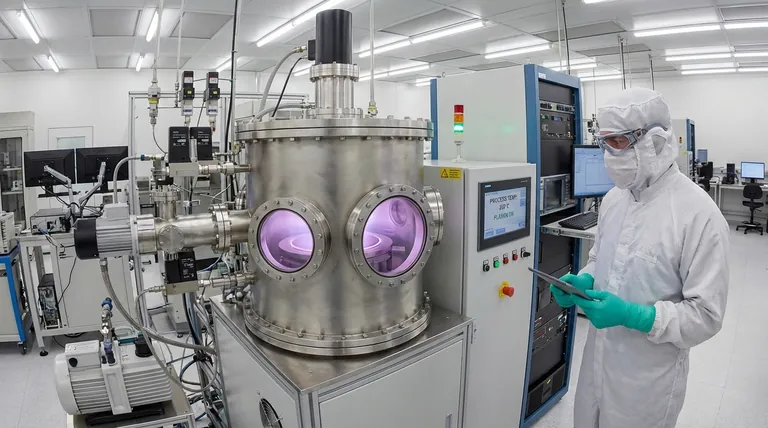In PECVD, increasing the deposition temperature directly improves the quality of the resulting film. Higher temperatures provide more energy for surface reactions, leading to denser films with lower hydrogen content, fewer defects like pinholes, and greater resistance to chemical etching. However, the primary advantage of PECVD is its ability to operate at much lower temperatures than conventional CVD, typically between 80°C and 400°C.
The core principle is a direct trade-off: You must balance the need for high-quality film, which favors higher temperatures, against the thermal limitations of your substrate material, which often necessitates lower temperatures.

The Role of Temperature in Film Quality
Temperature is one of the most critical levers in controlling the final properties of a PECVD film. It directly influences the surface mobility of precursor molecules and the efficiency of chemical bond formation.
The Impact of Higher Temperatures
At higher temperatures, typically approaching the 350°C to 400°C range, adatoms (adsorbed atoms) on the substrate surface have more thermal energy. This increased energy allows them to move more freely across the surface before settling into a fixed position.
This enhanced surface mobility results in a film that is more ordered, denser, and closer to its ideal stoichiometric state. Key indicators of this higher quality include lower hydrogen content and slower etch rates, as the denser material is more resistant to chemical attack.
The Consequences of Lower Temperatures
When deposition is performed at lower temperatures (e.g., 100°C to 250°C), the adatoms have less energy to find optimal lattice sites. This can lead to a more amorphous and porous film structure.
The most common consequence is a higher concentration of defects, such as pinholes. These films may also have higher incorporated hydrogen content, which can negatively impact their electrical and mechanical properties.
The Strategic Advantage of Low-Temperature Deposition
While higher temperatures yield better films, the defining feature of PECVD is its ability to successfully deposit high-quality films at temperatures that are fundamentally incompatible with other methods. This capability is enabled by the use of plasma to energize the reactant gases, reducing the need for purely thermal energy.
Protecting Heat-Sensitive Substrates
Many advanced applications involve substrates that cannot withstand high temperatures. PECVD's ability to operate from room temperature to 350°C makes it ideal for depositing films on polymers, plastics, or fully fabricated semiconductor devices with low-melting-point metals.
Minimizing Thermal Stress
When a film is deposited at a high temperature onto a substrate with a different coefficient of thermal expansion, significant stress develops as the wafer cools. This stress can cause film cracking, delamination, or warping of the substrate.
By using a lower deposition temperature, PECVD drastically reduces the internal stress in the film, leading to better adhesion and improved device reliability.
Preventing Unwanted Reactions
In complex, multi-layered device structures, high temperatures can cause elements from different layers to diffuse into one another. This cross-contamination can degrade or destroy device performance.
The low-temperature nature of the PECVD process minimizes this mutual diffusion and prevents unintended chemical reactions between the film and the underlying substrate.
Understanding the Trade-offs
The choice of deposition temperature is never made in a vacuum. It is a calculated decision based on the priorities of the specific application.
Film Quality vs. Substrate Integrity
This is the central trade-off. The goal is often to use the highest temperature that the substrate can safely tolerate without damage or degradation. For a robust silicon wafer, this may be 400°C. For a polymer substrate, this might be only 100°C.
Process Optimization
For any given substrate, there is an optimal temperature window that balances film quality, deposition rate, and stress. Operating outside this window, either too high or too low, can compromise the final device's performance and yield.
Making the Right Choice for Your Goal
Selecting the correct temperature requires a clear understanding of your primary objective.
- If your primary focus is maximum film density and durability: Use the highest temperature your substrate and equipment can safely handle, often in the 350-400°C range, to minimize hydrogen content and etch rate.
- If your primary focus is depositing on a heat-sensitive material: Begin at a low temperature (e.g., 80-150°C) and accept that the film may have lower density, or plan for subsequent annealing steps if the substrate allows.
- If your primary focus is minimizing stress in a multilayer device: Choose a moderate temperature that provides acceptable film quality while avoiding issues related to thermal expansion mismatch and interlayer diffusion.
Ultimately, temperature is the key process parameter used to tailor PECVD film properties to the specific constraints of your material and device.
Summary Table:
| Temperature Range | Primary Effect on Film | Key Consideration |
|---|---|---|
| High (350-400°C) | Denser, lower hydrogen, fewer defects | Risk of substrate damage, high stress |
| Low (80-250°C) | Higher hydrogen, more porous/amorphous | Protects sensitive substrates, low stress |
Need to optimize your PECVD process for specific film properties and substrate constraints? KINTEK specializes in lab equipment and consumables, serving diverse laboratory needs. Our experts can help you select the right PECVD system to achieve the perfect balance of film quality, substrate safety, and process efficiency. Contact us today to discuss your application and discover how we can enhance your research or production outcomes!
Visual Guide

Related Products
- HFCVD Machine System Equipment for Drawing Die Nano-Diamond Coating
- 915MHz MPCVD Diamond Machine Microwave Plasma Chemical Vapor Deposition System Reactor
- Vacuum Hot Press Furnace Machine for Lamination and Heating
- Laboratory Rapid Thermal Processing (RTP) Quartz Tube Furnace
- Graphite Vacuum Continuous Graphitization Furnace
People Also Ask
- What is microwave plasma CVD? A Guide to High-Purity Diamond and Material Synthesis
- How is diamond coating made? A Guide to CVD and PVD Methods
- What machine is used to make lab-grown diamonds? Discover the HPHT & CVD Technologies
- How do CVD diamonds grow? A Step-by-Step Guide to Lab-Grown Diamond Creation
- What is the process of coating deposition? A Step-by-Step Guide to Thin Film Engineering



















